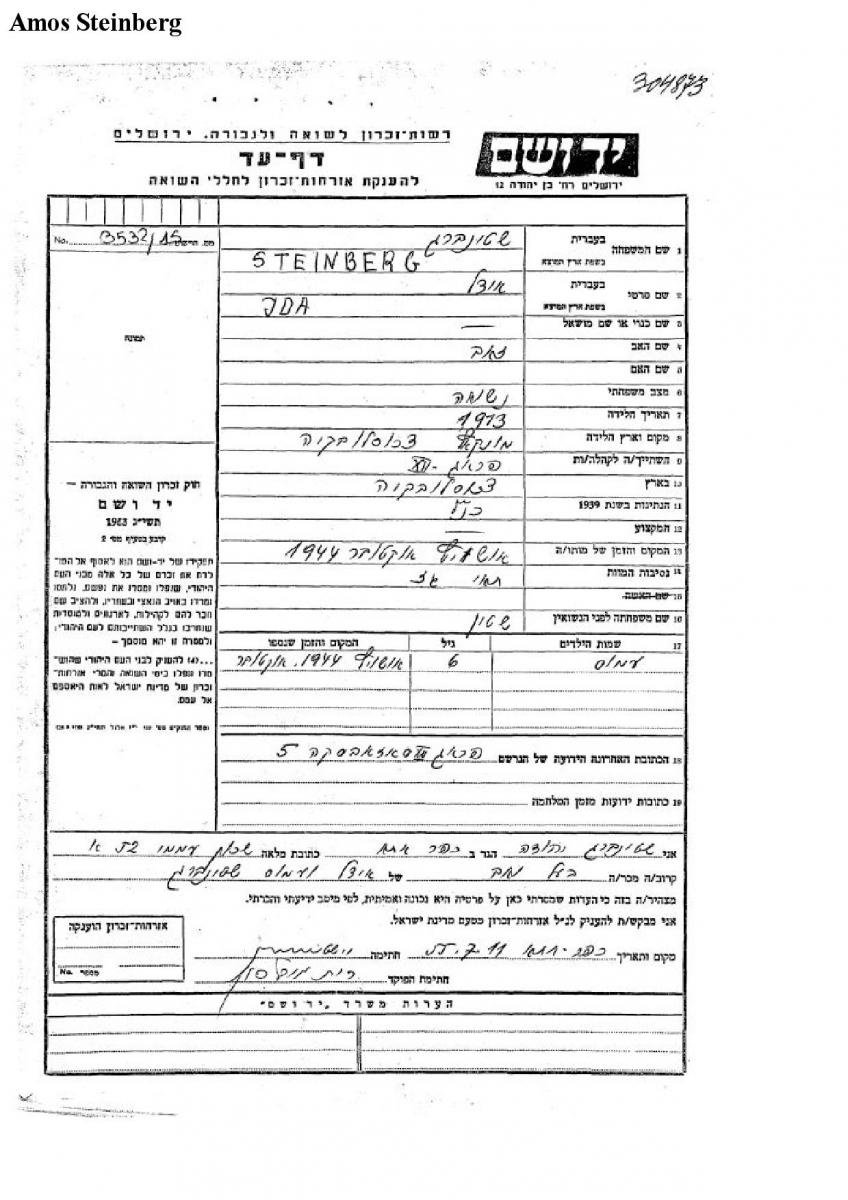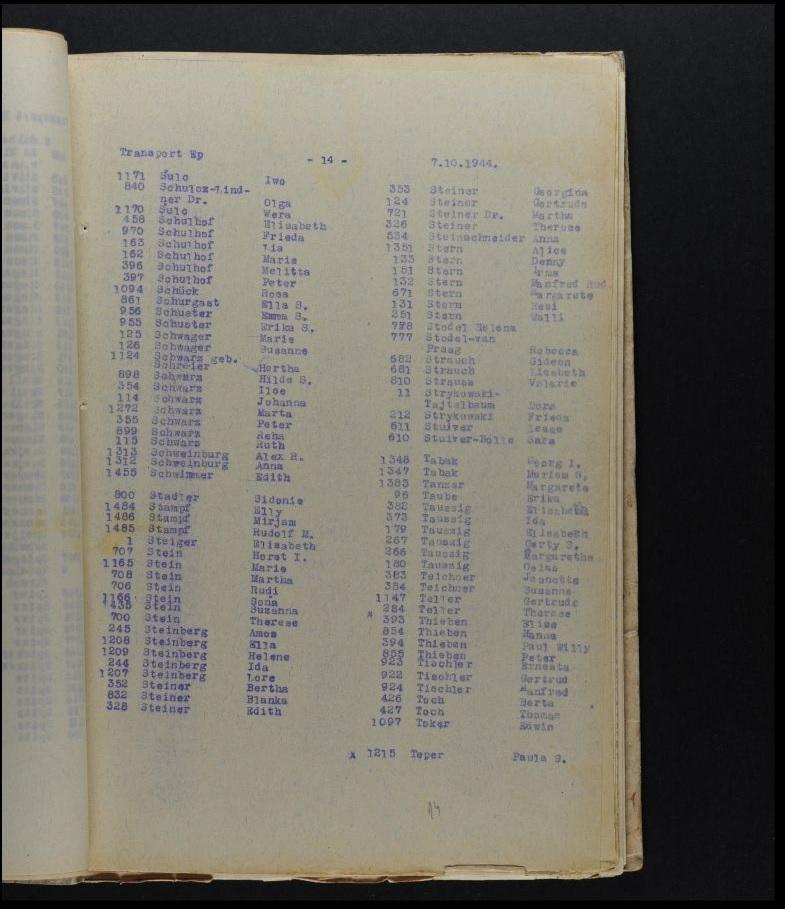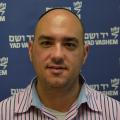
Yad Vashem Shoah Victims' Names Database


Yad Vashem Deportation Database

The memory of the Holocaust is a huge puzzle with many black holes. Each hole represents the personal stories of people – men, women and children – who were murdered simply because of the faith into which they were born. Yad Vashem continues to work alongside other Holocaust institutions to uncover these remaining missing pieces and safeguard them for all time.
Just last week, conservationists and researchers at the Auschwitz State Memorial uncovered documents found hidden inside a child's shoe –one of tens of thousands of shoes that are displayed at the site. Each belonged to a person – with hopes, dreams and families – who was cruelly murdered by the German Nazis at the Auschwitz-Birkenau concentration and extermination camp. Miraculously, the documents hidden in the shoe survived, and now, with the help of Yad Vashem's vast archival holdings, they can tell us the story of its owner, six-year-old Amos Steinberg, and his mother, Ida.
On the eve of World War II, Ida and Yehuda Steinberg and their son Amos were living in Prague. On 10 August 1942, along with many of the Jews of the Czechoslovakian capital, the Steinberg family was forced to move to the nearby Theresienstadt ghetto. A little over a year later, on 4 October 1944, Ida and Amos Steinberg were deported to Auschwitz. Shortly after their arrival, they were sent to their death in the gas chambers. The documents found hidden in one the children's shoes at Auschwitz contained identification records as well as handwritten documentation. This discovery provided researchers with vital information used to reveal the owner of the shoe – Amos Steinberg.
Experts at Yad Vashem's International Institute for Holocaust Research, which has been for the past decade cataloguing the deportations of Jews during the Holocaust, found the names of Ida and Amos on a transport list from Theresienstadt to Auschwitz. Of the approximately 1,500 Jews registered on this one particular transport, over 1,300 are counted among the 6 million murdered, including Ida and Amos.
Yehuda was deported on a later transport to Auschwitz and for there was taken to Dachau. In 1945, he was later liberated from the Kaufering concentration camp. After arriving in the newly established State of Israel in 1949 together with his new wife, Yehuda changed his family name to Shinan. In 1955, he filled out a Page of Testimony for Ida and their child, Amos. After the article appeared in the Israeli daily YNET, Yad Vashem spoke with the family of Yehuda Shinan about this unbelievable discovery.
Yehuda's children Prof. Avigdor Shinan and his sister Leah Shinan Shamir said:
"We were surprised to find out that it was the shoe of our brother. From now on, on his Hebrew yahrzeit [date of death], we will light a candle of remembrance and say Kaddish for their souls."
Leah Shamir Shinan continues:
"When I first saw this in the news, and saw the name Amos Steinberg, I could not believe my eyes. It is impossible to describe what I went through when I saw the photo of the shoe of Amos, and understood it belonged to my half-brother, who was murdered in Auschwitz together with his mother."
Leah and Avigdor both knew that their father was married and had a son before the war. However, like many survivors who lost their families in the Holocaust, he did not speak about it much in the house. Their mother, also a survivor who was also imprisoned in Theresienstadt during the Holocaust but was not deported to Auschwitz, spoke of the plaque at the site of the ghetto with the names of all the children who were interned there – Amos included.
Leah contemplates:
"Today, Amos would have been 82. Over the years, I have traveled a lot around the world, and everywhere I went I would look in the phone book, hoping that he survived. For us, this marks the closing of an unknown circle."
For the past seven-and-a-half decades since the end of World War II, a huge amount of research has been carried out on the Holocaust. Experts in genealogy and archives have been combing through millions of documents around the world, arduously working to restore the identities of the millions of Jewish and non-Jewish victims of Nazi persecution. Efforts to gather testimonies and documentation of the Holocaust began almost immediately after the liberation of the concentration and death camps. For seventy-five years, researchers have been working to piece together the puzzle of what – and whom – the German Nazis and their collaborators destroyed during 1933-1945.
Yad Vashem Archives Director Dr. Haim Gertner remarks:
"This discovery serves as a reminder to us that while the Holocaust took place so long ago, we are still experiencing the loss all these years later," . "We still have so much to learn about the history of the Holocaust. And, perhaps most importantly, we must continue to keep the memory of the Holocaust and its victims alive. We must ensure that what they endured never can happen again."
"Through its myriad activities and unrivalled collections of Holocaust-era documents, artifacts and artworks, Yad Vashem strives to restore the identities of the victims who were murdered in anonymity. We attempt to create as full an image of these people as we can, people like you and me. They were homemakers and professionals, religious and secular, comfortable and impoverished; they were also children with so much hope and possibility for their future. In this way they will not only be remembered as victims, but also as human beings.
"Yet despite all the information we have gathered over the decades, there still is so much to discover; like the shoe of Amos Steinberg, the missing pieces of a complex and scattered puzzle. Over a million names of Holocaust victims are still missing. We are now racing against the clock to gather the personal testimonies of Holocaust witnesses, the last of this generation. All these years later, our job remains far from finished."











